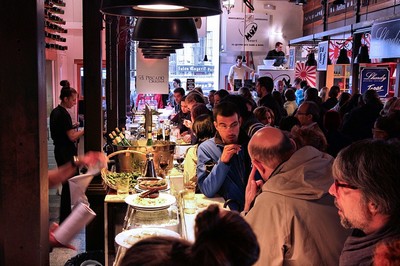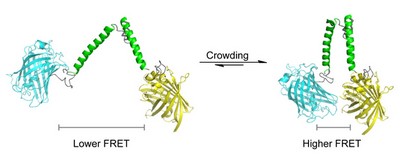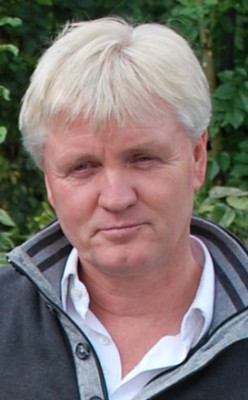The crowd inside your cells
Imagine yourself in a busy bar. You scan the crowd and your eyes fall upon a gorgeous hunk. He looks up, your eyes meet and there is instant chemistry. You simply have to get close to him and fast, but the other guests are in the way. Welcome to the world of the average molecule inside your cells.

There is a lot of attraction going on in cells: all sorts of molecules want to interact. Biochemists study these interactions in their test tubes, but conditions in the laboratory are often totally different from in a real cell. ‘A cell is full of all sorts of molecules’, explains University of Groningen Professor of Biochemistry Bert Poolman. And like the two people in the bar, molecules cannot move freely in such a crowded environment. ‘Diffusion rates are therefore much slower in a cell than in a test tube.’
One reason why biochemists fail to take crowding into account is the lack of detailed information on the phenomenon. ‘You have to estimate it from average volumes of cells and average concentrations of molecules’, explains Poolman. But that doesn’t give you the real picture. ‘Imagine a pop concert. Right in front of the stage, people are packed and can hardly move, but towards the back, there’s much more space.’
Biologists assumed that there were also different levels of crowding in different compartments of cells, but had no way to measure this reliably. Until now, that is, because Dr Arnold Boersma from Bert Poolman’s group has developed a molecular crowding sensor. Boersma and Poolman’s findings were published in the journal Nature Methods on 2 February.

Boersma and Poolman designed a protein ‘spring’ that is compressed in a crowded environment. Imagine yourself again in that busy bar, making your way towards the hunk. If it is very crowded, you will press your arms to your body to make yourself as small as possible, but if there is enough space, you’ll expand a bit.
For Boersma and Poolman the trick was to make the compression or expansion of the spring visible. They achieved this by placing fluorescent protein markers on both ends – the ‘arms’ of the molecule. The first marker emits a blue light when excited by laser light. This blue light in turn excites the second marker, which then emits a yellow light. This transfer of resonance energy is proportional to the distance between the markers; the technique is called ‘ Förster resonance energy transfer ’ (FRET).

The amount of yellow light is a measure of the distance between the markers, and this depends on the amount of compression due to crowding. In the paper, the scientists show that they can reliably measure how ‘crowded’ the cell cytosol is in living cells.
The sensor is encoded on an artificial gene, which is expressed in the cells. Boersma and Poolman developed two versions of the gene: one for bacteria and one for mammalian cells. ‘We will use this sensor to map the structure of the cytoplasm during the cell cycle’, says Poolman. ‘Our interest is in the way cells can regulate their volume, which obviously affects crowding. But it’s easy to envision many other applications for the sensor.’
Poolman is director of the Centre for Synthetic Biology at the University of Groningen. Synthetic biologists aim to engineer cells that could be used to produce pharmaceuticals or other useful molecules. But you can’t design a cell properly unless you know how it works. ‘The crowding affects all sorts of processes in the cell, from interaction rates and affinities of biomolecules to folding rates and fold stabilities.’
Reference: Arnold J Boersma1,2, Inge S Zuhorn3, and Bert Poolman1,2; A sensor for quantification of macromolecular crowding in living cells. Nature Methods DOI 10.1038/nmeth.3257
1 Groningen Biomolecular Sciences and Biotechnology Institute, University of Groningen, Groningen, the Netherlands. 2Zernike Institute for Advanced Materials, University of Groningen, Groningen, the Netherlands. 3Department of Cell Biology, University Medical Center Groningen, University of Groningen, Groningen, the Netherlands
| Last modified: | 26 January 2016 12.30 p.m. |
More news
-
10 June 2024
Swarming around a skyscraper
Every two weeks, UG Makers puts the spotlight on a researcher who has created something tangible, ranging from homemade measuring equipment for academic research to small or larger products that can change our daily lives. That is how UG...
-
21 May 2024
Results of 2024 University elections
The votes have been counted and the results of the University elections are in!

